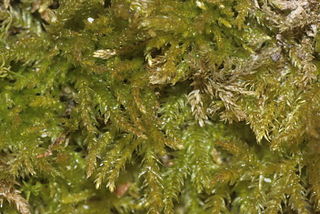
Lycopodium clavatum is the most widespread species in the genus Lycopodium in the clubmoss family.

Mollugo verticillata, the green carpetweed, is a rapidly spreading annual plant from tropical America. In eastern North America, it is a common weed growing in disturbed areas. It forms a prostrate circular mat that can quickly climb over nearby plants and obstacles. The species has been reported from every state in the United States except Alaska, Hawaii, and Utah, as well as from British Columbia, Manitoba. Ontario, Quebec, New Brunswick and Nova Scotia. Although considered an invasive weed, M.verticillata is also known to be edible. Archaeological evidence has shown that M. verticillata has been in North America for about 3000 years. Sometimes also referred to as "Indian chickweed", in China this plant is referred to as zhong leng su mi cao.

Bruchiaceae is a family of haplolepideous mosses (Dicranidae) in the order Dicranales. They have the greatest occurrence in temperate regions. They are mosses with long-necked, cleistocarpous capsules and mitrate calyptras.

Itatiella ulei is a species of moss in the family Polytrichaceae. It is the only species in the genus Itatiella. The Polytrichaceae is a common family of mosses that does not have close living relatives. Its small size and the inflexed leaf apex characterize Itatiella ulei. When this species grows directly exposed to sun at high elevations, it presents a similar aspect but can be distinguished based on the distal lamella cells which are single and rhombic.

Anomodon is a genus of mosses in the family Thuidiaceae.

Carex rariflora, the looseflower alpine sedge, is a species of plant in the sedge family. It is found in the United States in Alaska and Maine, and in Canada in New Brunswick and Nova Scotia. In these regions, it is ranked as an obligate hydrophyte in establishing wetland areas. It prefers wet environments such as open bogs, meadows, seepage slopes, and low-elevation heath tundra. This perennial grass, which can be up to 3 feet tall, has fibrous roots, and holds all perennial organs underground. The leaves are alternate, long, narrow, and simple, with parallel veins. They grow in dense clusters, and the dead leaves are found at the base of the plant. The plant blooms and fruits in the summer. All flowers are monoecious and unisexual, producing a spike inflorescence. All inflorescences are subtended by shorter, proximal bracts.

Andreaea rothii, or Roth's andreaea moss, is a species of moss in the family Andreaeaceae native to North America and parts of Europe. This plant was described in 1807 by Weber and Mohr.

Brunnichia ovata is a species of the buckwheat family that is found in North America. It was reassigned from the genus Rajania to Brunnichia by Lloyd Shinners in the publication Sida in 1967. Formerly it had been placed in Rajania by Thomas Walter in Flora Caroliniana in 1778. Brunnichia ovata plants grow near riverbanks, the perimeters of lakes, wet woods and thickets. This species is found in the buckwheat family, Polygonaceae. Brunnichia ovata is referred to by two other common names including American buckwheat vine and redvine.

Fissidens limbatus commonly known as Herzog's pocket-moss, is a moss in the family Fissidentaceae. This species is found growing in high elevations in tropical America in addition to the US, Mexico and Canada. Montagne first collected F. crispus in 1838.

Plagiomnium cuspidatum, also known as toothed or “baby-tooth” plagiomnium moss and woodsy thyme-moss, is a species of thyme-moss that originated in North America, but can now also be found throughout Middle America, Africa, Northern and Southern Asia, and Europe.

Plagiomnium venustum, also known as magnificent leafy moss, is a species of moss belonging to the family Mniaceae. It is found mainly in western North America along the coastal region. This moss can be identified from other members of the Plagiomnium genus by dark coloured stomata guide cells and the absence of sterile stems. It is most commonly found growing as a mat on a variety of substrate, but mainly on humus and moist soil.

Orthotrichum lyellii, also known as Lyell's bristle moss, is a species of acrocarpous moss belonging to the family Orthotrichaceae. O. lyellii can be found throughout western North America and Europe. It is found most commonly growing epiphytically on a variety of trees, and less commonly on rocks or boulder substrates.

Cynoglossum zeylanicum, also called the Ceylon hound's tongue, Ceylon forget-me-not, and Indian hound's tongue, is a species of flowering plant in the family Boraginaceae. It is found throughout Asia. It has also been introduced to the Americas.

Kindbergia praelonga, known as common feather-moss, is a species of moss belonging to the family Brachytheciaceae. It is a medium to large size moss with pinnate leaves. The species is of interest for having properties that may be beneficial for human health.
Bryocrumia vivicolor is a rheophytic species of moss belonging to the family Hypnaceae, and is the sole representative of the genus Bryocrumia.
Crumia latifolia is a species of moss belonging to the family Pottiaceae, and is the sole representative of the genus Crumia.

Eurhynchiastrum pulchellum is a species of mosses belonging to the family Brachytheciaceae. It is the sole species of the genus Eurhynchiastrum.

Ulota crispa, the crisped pincushion moss, is a species of acrocarpous moss in the genus Ulota native to eastern North America. It is generally found in tight mounds on tree bark.

Sphagnum contortum is a species of moss reported in North America and Europe. NatureServe marked its global conservation status as Secure.
Atrichum crispum is a species of moss. It is dioicous with males being the same size as females or larger.

















